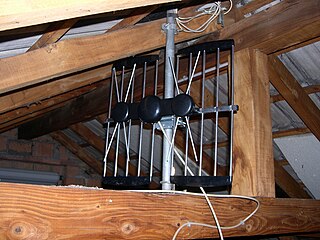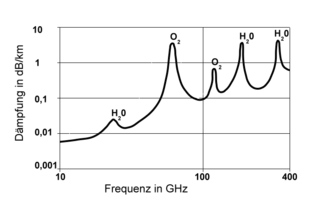
IEEE 802.11 is part of the IEEE 802 set of LAN protocols, and specifies the set of media access control (MAC) and physical layer (PHY) protocols for implementing wireless local area network (WLAN) Wi-Fi computer communication in various frequencies, including but not limited to 2.4, 5, and 60 GHz frequency bands.
The industrial, scientific and medical (ISM) radio bands are radio bands reserved internationally for the use of radio frequency (RF) energy for industrial, scientific and medical purposes other than telecommunications. Examples of applications in these bands include radio-frequency process heating, microwave ovens, and medical diathermy machines. The powerful emissions of these devices can create electromagnetic interference and disrupt radio communication using the same frequency, so these devices were limited to certain bands of frequencies. In general, communications equipment operating in these bands must tolerate any interference generated by ISM applications, and users have no regulatory protection from ISM device operation.

Microwaves are a form of electromagnetic radiation with wavelengths ranging from about one meter to one millimeter; with frequencies between 300 MHz (1 m) and 300 GHz (1 mm). Different sources define different frequency ranges as microwaves; the above broad definition includes both UHF and EHF bands. A more common definition in radio engineering is the range between 1 and 100 GHz. In all cases, microwaves include the entire SHF band at minimum. Frequencies in the microwave range are often referred to by their IEEE radar band designations: S, C, X, Ku, K, or Ka band, or by similar NATO or EU designations.
The Ku band is the portion of the electromagnetic spectrum in the microwave range of frequencies from 12 to 18 gigahertz (GHz). The symbol is short for "K-under", because it is the lower part of the original NATO K band, which was split into three bands because of the presence of the atmospheric water vapor resonance peak at 22.24 GHz, (1.35 cm) which made the center unusable for long range transmission. In radar applications, it ranges from 12-18 GHz according to the formal definition of radar frequency band nomenclature in IEEE Standard 521-2002.

Ultra high frequency (UHF) is the ITU designation for radio frequencies in the range between 300 megahertz (MHz) and 3 gigahertz (GHz), also known as the decimetre band as the wavelengths range from one meter to one tenth of a meter. Radio waves with frequencies above the UHF band fall into the super-high frequency (SHF) or microwave frequency range. Lower frequency signals fall into the VHF or lower bands. UHF radio waves propagate mainly by line of sight; they are blocked by hills and large buildings although the transmission through building walls is strong enough for indoor reception. They are used for television broadcasting, cell phones, satellite communication including GPS, personal radio services including Wi-Fi and Bluetooth, walkie-talkies, cordless phones, and numerous other applications.
Super high frequency (SHF) is the ITU designation for radio frequencies (RF) in the range between 3 and 30 gigahertz (GHz). This band of frequencies is also known as the centimetre band or centimetre wave as the wavelengths range from one to ten centimetres. These frequencies fall within the microwave band, so radio waves with these frequencies are called microwaves. The small wavelength of microwaves allows them to be directed in narrow beams by aperture antennas such as parabolic dishes and horn antennas, so they are used for point-to-point communication and data links and for radar. This frequency range is used for most radar transmitters, wireless LANs, satellite communication, microwave radio relay links, and numerous short range terrestrial data links. They are also used for heating in industrial microwave heating, medical diathermy, microwave hyperthermy to treat cancer, and to cook food in microwave ovens.
The S band is a designation by the Institute of Electrical and Electronics Engineers (IEEE) for a part of the microwave band of the electromagnetic spectrum covering frequencies from 2 to 4 gigahertz (GHz). Thus it crosses the conventional boundary between the UHF and SHF bands at 3.0 GHz. The S band is used by airport surveillance radar for air traffic control, weather radar, surface ship radar, and some communications satellites, especially those used by NASA to communicate with the Space Shuttle and the International Space Station. The 10 cm radar short-band ranges roughly from 1.55 to 5.2 GHz. The S band also contains the 2.4–2.483 GHz ISM band, widely used for low power unlicensed microwave devices such as cordless phones, wireless headphones (Bluetooth), wireless networking (WiFi), garage door openers, keyless vehicle locks, baby monitors as well as for medical diathermy machines and microwave ovens. India’s regional satellite navigation network (IRNSS) broadcasts on 2.483778 to 2.500278 GHz.
The V band ("vee-band") is a standard designation by the Institute of Electrical and Electronic Engineers (IEEE) for a band of frequencies in the microwave portion of the electromagnetic spectrum ranging from 40 to 75 gigahertz (GHz). The V band is not heavily used, except for millimeter wave radar research and other kinds of scientific research. It should not be confused with the 600–1000 MHz range of Band V of the UHF frequency range.

The radio spectrum is the part of the electromagnetic spectrum with frequencies from 30 Hertz to 300 GHz. Electromagnetic waves in this frequency range, called radio waves, are extremely widely used in modern technology, particularly in telecommunication. To prevent interference between different users, the generation and transmission of radio waves is strictly regulated by national laws, coordinated by an international body, the International Telecommunication Union (ITU).

Extremely high frequency (EHF) is the International Telecommunication Union (ITU) designation for the band of radio frequencies in the electromagnetic spectrum from 30 to 300 gigahertz (GHz). It lies between the super high frequency band, and the far infrared band, the lower part of which is also referred to as the terahertz gap. Radio waves in this band have wavelengths from ten to one millimetre, so it is also called the millimetre band and radiation in this band is called millimetre waves, sometimes abbreviated MMW or mmW. Millimetre-length electromagnetic waves were first investigated in the 1890s by Indian scientist Jagadish Chandra Bose.

High-speed multimedia radio (HSMM) is the implementation of wireless data networks over amateur radio frequencies using commercial off-the-shelf (COTS) hardware such as 802.11 access points. Only licensed amateur radio operators may use amplifiers and specialized antennas to increase the power and coverage of the 802.11 signal.
The W band of the microwave part of the electromagnetic spectrum ranges from 75 to 110 GHz, wavelength ≈2.7–4 mm. It sits above the U.S. IEEE-designated V band (40–75 GHz) in frequency, and overlaps the NATO designated M band (60–100 GHz). The W band is used for satellite communications, millimeter-wave radar research, military radar targeting and tracking applications, and some non-military applications.

Microwave transmission is the transmission of information by microwave radio waves. Although an experimental 40-mile (64 km) microwave telecommunication link across the English Channel was demonstrated in 1931, the development of radar in World War II provided the technology for practical exploitation of microwave communication. In the 1950s, large transcontinental microwave relay networks, consisting of chains of repeater stations linked by line-of-sight beams of microwaves were built in Europe and America to relay long distance telephone traffic and television programs between cities. Communication satellites which transferred data between ground stations by microwaves took over much long distance traffic in the 1960s. In recent years, there has been an explosive increase in use of the microwave spectrum by new telecommunication technologies such as wireless networks, and direct-broadcast satellites which broadcast television and radio directly into consumers' homes.
The Q band is a range of frequencies contained in the microwave region of the electromagnetic spectrum. Common usage places this range between 33 and 50 GHz, but may vary depending on the source using the term. The foregoing range corresponds to the recommended frequency band of operation of WR22 waveguides. These frequencies are equivalent to wavelengths between 6 mm and 9.1 mm in air/vacuum. The Q band is in the EHF range of the radio spectrum.

5G is the latest generation of cellular mobile communications. It succeeds the 4G, 3G and 2G (GSM) systems. 5G performance targets high data rate, reduced latency, energy saving, cost reduction, higher system capacity, and massive device connectivity. The first phase of 5G specifications in Release-15 will be completed by April 2019 to accommodate the early commercial deployment. The second phase in Release-16 is due to be completed by April 2020 for submission to the International Telecommunication Union (ITU) as a candidate of IMT-2020 technology.
The waveguide D band is the range of radio frequencies from 110 GHz to 170 GHz in the electromagnetic spectrum, corresponding to the recommended frequency band of operation of the WR6 and WR7 waveguides. These frequencies are equivalent to wave lengths between 2.7 mm and 1.8 mm. The D band is in the EHF range of the radio spectrum.
The waveguide E band is the range of radio frequencies from 60 GHz to 90 GHz in the electromagnetic spectrum, corresponding to the recommended frequency band of operation of WR12 waveguides. These frequencies are equivalent to wave lengths between 5 mm and 3.333 mm. The E band is in the EHF range of the radio spectrum.
The IEEE K band is a portion of the radio spectrum in the microwave range of frequencies from 18 to 27 gigahertz (GHz). The range of frequencies in the center of the K band between 18 and 26.5 GHz is absorbed by water vapor in the atmosphere due to its resonance peak at 22.24 GHz, 1.35 cm. Therefore these frequencies experience high atmospheric attenuation and cannot be used for long distance applications. For this reason the original K band has been split into three bands, Ka band, K-band, and Ku band as detailed below.









